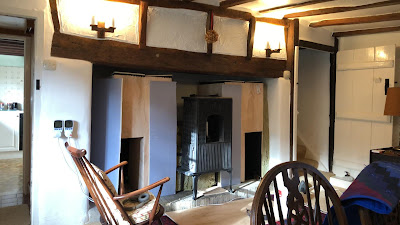The full problem
In a previous post I've solved issues of a farmer trying to maximise the area of their field using a given length of fence. Given that was solvable I thought, well what if rather
than a wall the farmer was to use a circular lake?
This is also modelable but the answer isn’t as intuitive. I would argue the
reason the answer isn’t as intuitive is that the more of the fence circle you
use, the more the lake invades the pasture. There must be some benefit in
using the edge of the lake though, at least my intuition leads me to believe.
Here I try to go about calculating the systems in the same way as in the previous post.
Let the reflex angle BAD represents the large simple area of the
pasture.
The segment ABE represents half the remaining segment, bearing in mind that
not all of this is usable.
The area BEFB is subtracted from this and represents the area covered by water
that would otherwise make the remainder of the arc.
This can be calculated in a similar way to the circle against a wall example
leading us to a formula for the total area of the pasture.
We are assuming that the length BC is fixed and given to us. We need to know
the radius of the pond/lake to work out the answer. The angle C is, however,
dependent on how we arrange the fence.
The angle of C can be calculated using the fact that we can work out from the
angle A and the length AB (which can be calculated given we know the length of
fence) the length BD.
If we have BD and BC we can use trigonometry to find the angle C.
One of the problems here is that we have trig functions in 2 angles, however
we can convert them to one.
Along the way in this calculation we have a lot of choice in what we express
ourself in terms of. Here we have choses to try and express everything as
closely as possible in terms of theta. For the next step we can chose to
represent the calculation either in terms of theta, or in terms of R. Both are
linked by the equation:
Which brings us back to the original question. The length of the fence,
S, is fixed. That means that changing the angle and the radius of the circle we make with the fence are interlinked.
Substituting:
We get:
Which is starting to get a bit ridiculous. However, every variable other than theta is now constant. Which makes the differentiation process long but procedural.
The following identity makes the task a little simpler by breaking it into 3
separate differentiations.
Redefining theta
For the sake of my sanity I am redefining theta here to two theta to make life
easier:
This need to be back propagated through the equations:
You can see this is blowing up in it’s complexity.
Let us give beta a go, this one is made more complicated by the inverse trig
function.
We have used it before but I think it helps here to make it more explicit.
Here is the chain rule:
There is a huge amount going on here, but one point of note is that things are
a little simplified by the use of delta inside the square root is squared
which does make things a little simpler.
First we need to simplify our equation for the differential of delta:
Onto differentiating the final term of our equation Gamma.
That is where the story ends for now. The sum of the three calculated
differentials should be set to zero and the equation solved for theta. Given
the nature of the calculation it seems that the solution is transcendental and
so there is little hope of getting an analytical solution.
Perhaps there are some tools that are not yet in my mathematical toolbox which
will yield a more fruitful search for answers.


Comments
Post a Comment